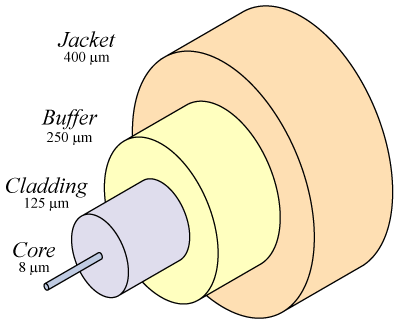
Modern data transmission is now built on optical fibers, which are used for everything from telecom and internet services to governmental and space applications. This is due to the fact that, when compared to other technologies, they can transmit larger amounts of data at faster rates and over greater distances.
However, the design of optical fibers can occasionally result in network failures as any twisted or bent cables can impede data transmission. Scientists at the University of Bath in the UK have created a new type of fiber to help solve this problem and improve the reliability of these networks.
A regular optical fiber consists of three elements: the core, the cladding, and the coating.
Light (the medium through which data is transmitted) can move through the core, which is at the center. The cladding confines the light inside the core and directs its path, causing it to bounce off a mirror-like surface. Finally, the coating serves as the main buffer, and the whole structure is enclosed in a jacket.

“Whenever you fabricate a fiber-optic cable, small variations in the physical structure of the fiber are inevitably present. When deployed in a network, the fiber can also get twisted and bent,” Physics PhD student Nathan Roberts — who led the research — said.
“One way to counter these variations and defects is to ensure the fiber design process includes a real focus on robustness. This is where we found the ideas of topology useful,” Roberts added.
Topology is the mathematical study of the characteristics of geometric objects that hold true even after being bent, stretched, and deformed. The Bath researchers are the first to employ it in optical fibers, despite the fact that it has already been used in physics and light research.
By including multiple light-guiding cores in the fiber and connecting them in a spiral, the physicists have developed a fiber that makes use of topological principles. Even though light can still move between these cores, the topological structure of the system keeps it confined to the edge. These so-called “edge states” are protected from structural disorder.
“By adopting optical fibers with topological design, researchers will have the tools to pre-empt and forestall signal-degrading effects by building inherently robust photonic systems,” Dr Anton Souslov, co-author of the study, explained.
The scientists are currently seeking industry collaborators to advance the concept, which has the potential to benefit both present communications and upcoming quantum networks.
Roberts said “We have shown that you can make kilometers of topological fiber wound around a spool. We envision a quantum internet where information will be transmitted robustly across continents using topological principles,”
Quantum technology is anticipated to be significantly more powerful than conventional computers when it comes to storing and processing data, while also promising an unmatched (until now) level of data security — a potential game-changer for information networks.
In general, the new Optic Fiber is greatly going to improve the future of Quantum with this development.






